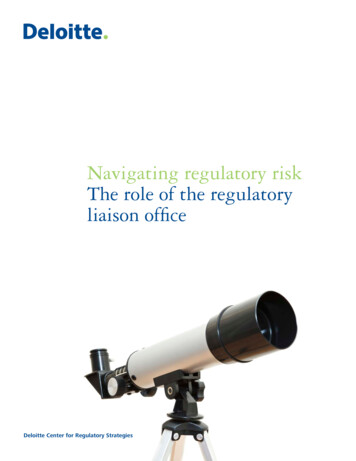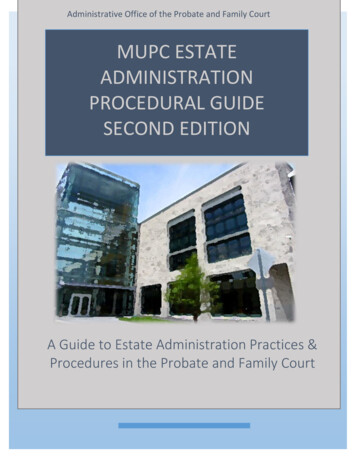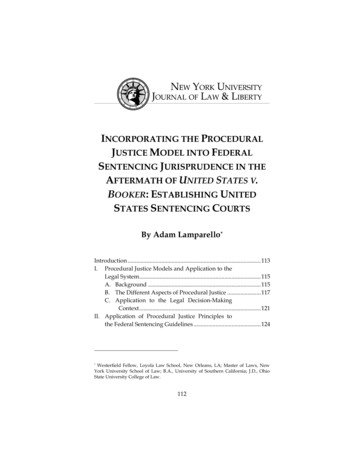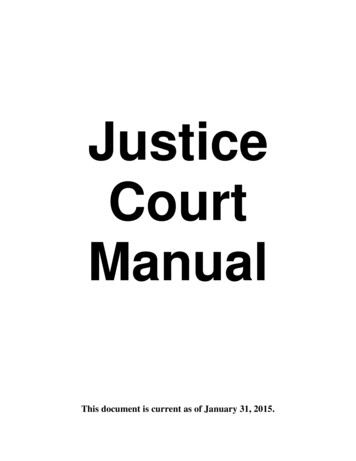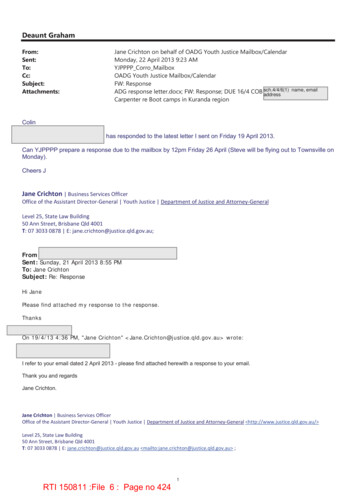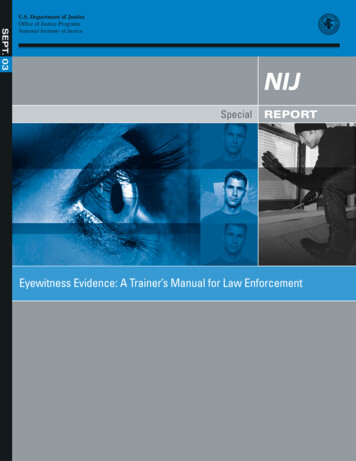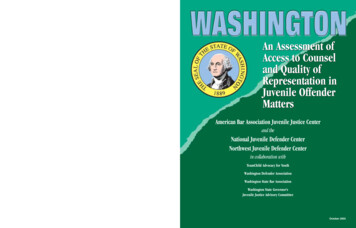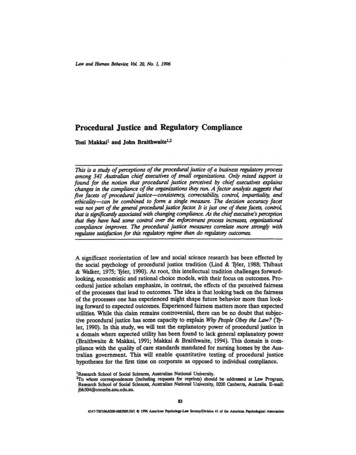
Transcription
Law and Human Behavior, VoL 20, No. 1, 1996Procedural Justice and Regulatory Compliance'Ibni Makkai 1 and John Braithwaite 1 This is a study of perceptions of the procedural justice of a business regulatory processamong 341 Australian chief executives of small organizations. Only mixed support isfound for the notion that procedural justice perceived by chief executives explainschanges in the compliance of the organizations they run. A factor analYsis suggests thatfive facets of procedural justice--consistency, correctability, control impartiality, andethicality--can be combined to form a single measure. The decision accuracy facetwas not part of the general procedural justice factor. It is just one of these facets, contro that is significantlY associated with changing compliance. As the chief executive'sperceptionthat they have had some control over the enforcement process increases, organizationalcompliance improves. The procedural justice measures correlate more strongly withregulatee satisfaction for this regulatory regime than do regulatory outcomes.A significant reorientation of law and social science research has been effected bythe social psychology of procedural justice tradition (Lind & Tyler, 1988; Thibaut& Walker, 1975; Tyler, 1990). At root, this intellectual tradition challenges forwardlookingl economistic and rational choice models, with their focus on outcomes. Procedural justice scholars emphasize, in contrast, the effects of the perceived fairnessof the processes that lead to outcomes. The idea is that looking back on the fairnessof the processes one has experienced might shape future behavior more than looking forward to expected outcomes. Experienced fairness matters more than expectedutilities. While this claim remains controversial, there can be no doubt that subjective procedural justice has some capacity to explain Why People Obey the Law? (Tyler, 1990). In this study, we will test the explanatory power of procedural justice ina domain where expected utility has been found to lack general explanatory power(Braithwaite & Makkai, 1991; Makkai & Braithwaite, 1994). This domain is compliance with the quality of care standards mandated for nursing homes by the Australian government. This will enable quantitative testing of procedural justicehypotheses for the first time on corporate as opposed to individual compliance.IResearch School of Social Sciences, Australian National University.21"o whom correspondences (including requests for reprints) should be addressed at Law Program,Research School of Social Sciences, Australian National University, 0200 Canberra, Australia. X)4]083509,50fl9 1996 American Ps hology-Law Society/Divlsion 41 of the American Psychological t i o n
84Makkai and BraithwaiteIt might be said that the social psychology of procedural justice constructstheories of individual behavior, so there is no reason to expect that it would berelevant to corporate conduct. On the contrary, qualitative research on corporatecompliance with regulatory laws that has been conducted by sociologists, politicalscientists, and business scholars has been replete with observations of managers'perceptions of procedural injustice undermining corporate commitments to compli ance (Bardach & Kagan, 1982; Braithwaite, 1985; Levi, 1988; Sigler & Murphy,1988; Vogel, 1986). While the procedural justice tradition is primarily about microencounters between individuals (but see Lind, Kulik, Ambrose, & de Vera Park,1993; Lind & Tyler, 1988), there is a parallel tradition of political theory at themacro level of whole societies which advances the proposition that states securethe compliance of their people when they strike a policy bargain that the citizenryperceives as just. Levi calls this the theory of contingent consent (Levi, 1993). Thestudy of corporate compliance involves a test of the conceptual tools of proceduraljustice that is intermediate between individual and societal compliance.The capacity to abuse the organizational form enables the organizational actorto "pass on" resentments fueled by perceived injustice in ways that non-organiza tional actors cannot. This extends even to passing through the organization theimpact of sanctions that are perceived as unfair:.Facilities will steal the money to pay fines from food or medical supplies because he Is/c]resents it. He sure won't take it out of profits or the Administrator's salary if he doesn'tthink the fine was fair. Because he resents it, he'll spite the bureaucrats by cutting themeat and eggs expenditure and blame the bureaucrats in his own mind for the way the patientsare made to pay. (Executive Director of a U.S. state nursing home trade association)A number of different facets of the procedural justice domain have been suggested in the literature. Drawing on Leventhal (1980) and Tyler (1988), six facets ofprocedural justice are identified in this paper--consistency, decision quality or accuracy, correctability, control, impartiality, and ethicality. Consistency is Leventhal's(1980) first criterion of procedural justice. It can mean consistency across time, butits important meaning in the domain of business regulation is consistent treatmentof different businesses. This is the sense in which consistency is used in this article. 3While consistency equates with the scientific conception of reliability, decision accuracy or quality equates with validity. It means doing what is necessary to get thedecision right (Tyler, 1988). Correctability means being able to complain about unfairness by a law enforcer to some "agency or organization" (Tyler, 1988, p. 113).Control was partitioned by Thibaut and Walker (1975) into process control and decision control, while Leventhal (1980) combines them in his notion of representation.Impartiality means absence of bias. The most important forms of preventionof favouritism or external bias in Australian society are t h e elimination of bias onthe basis of race, sex, age, nationality or other characteristics of persons. Ethicalityis the most vaguely defined of the procedural justice facets. Tyler (1988) defines itas "the degree to which the decision-making process accords with general standardsof fairness and morality" (p. 105). This gives it a meaning with little more specificitySin a way, there is neither the reality nor the pretense of consistency across time in this domain becausewe are dealing with a new regulatory program (which was accepted as being thoroughly inconsistentwith the past).
Precedural Justice85than the broad d o m a i n of procedural fairness itself. When Tyler (1988) comes tooperationalize ethicality, he does so in two ways--perceptions of politeness andconcern for rights. We prefer to view politeness as something conceptually quitedifferent from ethicality (and indeed o m procedural justice)? Our preference isfor Tyler's second specification of ethicality as respect for rights.THE NURSING HOME STUDYTo test the importance of a perceptual model of procedural justice on organizational compliance, a panel design was used with two waves of inspection dataand interviews with chief executive officers (directors of nursing). Such data wereprovided from a study of Australian nursing homes surrounding the four largestmetropolitan centers in Australia where more than two-thirds of all nursing homesin Australia are located. In 1987 the Australian government moved to take overfrom state governments the monitoring and enforcement of standards of quality ofcare in nursing homes throughout Australia. At this time they also replaced theinput standards that had been used to regulate the industry with 31 new outcomestandards covering seven main objectives--health care, social independence, freedom of choice, privacy and dignity enjoyed by residents, the environment of thenursing home, the variety of experience available to residents, and safety (includingrisks from fire, violence, infection and the use of restraints). 5An initial sample of 410 nursing homes were inspected over a two year period. 6 The procedure for inspecting nursing homes is straightforward. A team ofnot fewer than two, one of whom must always be a trained nurse, visits the nursinghome for an average of 6.5 hours. The team is required to inspect and rate eachof the 31 standards as met, action required or urgent action required. Followingthis there is a compliance meeting between the nursing home and the inspectionteam where the team discusses its initial ratings with staff. Negotiation over theaccuracy of the ratings sometimes requires the inspection team to revisit the hometo gather further information. In this meeting the appropriate action plans to bringthe nursing home into compliance are discussed and are included in the final report.4Indeed, there is a correlation of only .17 between our measure of ethicalityin Table II and a 7-pointrating of the inspection team as "courteous" at one pole to "rude" at the other measured at time 1.When the courteous-ruderating is entered into the regressionin Table V it is not a significantpredictor.5See Braithwaite, Braithwaite, Gibson, Landau, and Malckai (1991) for a detailed discussion of thestandards.eThe governmentagreed to inspecta proportionaterandom sample (stratifiedby size, type of ownership,and level of disabilityof residents) of 242 nursing homes over a 20-month period. In order to increasesample size all additional homes inspected within the sampling regions during this time flame wereincluded in the study (n 168). The random and supplementarysamples were compared on a rangeof factors (see Braithwaite,Makkai,Braithwalte, Gibson, & Ermann, 1990). There were no substantialdifferences between these two groups of homes in terms of geographical and organizationalcharacteristics of the nursing home, the sociodemographiccharacteristicsand attitudes of the directorsof nursing, and the nursing home's compliance ratings. On this basis the two groups have beencombined. However,the models includea control variable indicatingwhether or not the nursing homewas part of the random sample.
86Makkai and BraithwaiteWithin ten days of the compliance meeting the final report is sent to the nursinghome w h o have six weeks in which to object to its contents. It is these 31 ratings that provide the dependent measure of organizationalcompliance. A separate study has shown that the standards are reliable, valid, andcomprehensive i n their coverage of the medical, personal, and social needs of thenursing home's residents (Braithwaite, Bralthwaite, Gibson, Landau, & Mzkkai,1992). On this basis, the standards are summed to form a total measure of compliance ranging from 0 (no compliance) to 31 (absolute compliance). Test-retestreliabflities based on independent inspectors rating 50 homes ranged from .93 to.96 (Bralthwalte et al, 1992).Following the finalization of the first inspection report, each director of nursingwas asked to participate in a face-to-face interview. These interviews were extensive, oftenlasting up to three hours or into a second sitting. A wide range of issues were covered,two of which are important for this article--perceptions of procedural justice anddecision accuracy. A 96% response rate was obtained for the random sample homes.A second inspection was undertaken of 341 of the initial 410 homes, mostly18 to 20 months later, s One hundred and three of these homes had changed theirchief executive officer between the two inspections. The directors of nursing of theremaining 238 homes were mailed a questionnaire following the completion of theinspection team's report. To ma miTe response rates, two follow-up letters weremailed to the respondents and the final follow-up was undertaken by telephone.Five directors of nursing refused to participate and 36 failed to return a completedschedule, resulting in a response rate of 83%.9 To properly assess the importance of procedural justice it is necessary to focusnot on compliance at some point in time but on whether compliance has improvedover time. Perceptions of the procedural justice afforded to nursing homes by inspectors are assumed to be formed by the first encounters with standards monitoring teams experienced during the period from their first inspection through to theirsecond inspection. Since we are testing the effect of an intervention during a finiteperiod of time rather than the effect of an ongoing structural feature of the environment, a change in compliance model is the correct one. Improvement in compliance is most effectively captured by using the total compliance score at thesecond inspection as the dependent variable and controlling for compliance at thefast inspection as a baseline against which to measure change. T h e addition of thefirst inspection ratings as a control in "Ihble III partials out the nursing home'sinitial performance, leaving only the change in performance as the dependent vari7In the early days of monitoring the nursing homes, the report was sent to the proprietor of the homewho then passed it on to the director of nursing. This changed in 1988 so that the report was sent toboth the proprietor and the director of nursing.SSee Braithwalte, Makkai, Braithwaite, and Gibson (1992) for a detailed discussion of the follow-uprates for the study. Although preliminary data analyses indicated that the time between the first andsecond inspections did not significantly affect compliance, the time between the two inspections hasbeen included in the model as a control variable. Analyses were undertaken to determine if there wereany significant differences between homes that had, and had not, been visited by an inspection team.Out of seven characteristics of the director of nursing, four characteristics of the nursing home andthree characteristics of the proprietor, only one characteristic of the director of nursing was found tosignificantly differ (p .01) ('Braithwaite et al, 1992).
Procedural Justice8'7able. This also has the effect of controlling for a variety of factors that have beenshown in previous work to affect corporate compliance among nursing homes (seeMakkai & Braithwaite, 1991). These factors include the type of ownership, size andage of the nursing home, and nursing resident profile. As there is no theoreticalrationale as to why these factors should also affect change in the level of compliance(compliance at time 2 controlling for compliance at time 1) it is assumed that thecontrol for initial compliance captures all of their effects.The model does control for two additional factors. The first and most important is the geographical location of the nursing home. This factor was shown to beimportant in predicting first wave compliance, but as our fieldwork suggests thatinterstate differences in regulatory styles may have varied across time, this will impact on change in compliance. Three dummy variables are used to capture the fourgeographical regions--Queensland, Victoria, New South Wales, and South Australia. South Australia has been chosen as the excluded category as nursing homeslocated in this state had significantly lower levels of compliance than the nursinghomes in the other three states. The second control variable is whether or not thenursing home had been selected as part of the original random sample.In the models we also include measures of two alternative hypotheses--theuse of praise and subjective perceptions of deterrence. These rival measures allowsome comparison of procedural justice with the explanatory power of competingtheories. Praise was selected for inclusion in the model because of previous evidencethat it affects compliance (Makkai & Braithwaite, 1993) and because of the plausibility of the claim that inspectors who are procedurally fair will also be inspectorswho offer a lot of praise. A procedural justice finding will be more robust if itshows an effect over and above the effect of praise. The praise measure is a composite scale of the use of eight different approaches to encourage compliance asreported by the individual team members (Makkai & Braithwaite, 1993). Directorsof Nursing were asked the following questions:Different approaches will work under different circumstances in getting nursing homes tocomply with government standards. How often have you used each of the followingapproaches to encourage compliance with the standards? Very often used, Quite oftenused, Sometimes used, Rarely used and Never used?Appendix A shows the individual items. Responses to these items were summedresulting in a praise scale vith a mean of 5.62, standard deviation of 2.43, and aCronbach alpha of .80. The final scale has a mean of 5.62, standard deviation of2.43, with a Cronbach alpha of .80.As the inspection process is a team exercise, praise scores were averagedacross the multiperson teams and then matched to the nursing home that the teaminspected. Although 74% of inspectors returned usable questionnaires, 9 there wereonly 187 homes for which all members of the team answered a questionnaire, andthere were 13 homes where no member of the team returned a questionnaire. Theselatter homes have been excluded from the analyses. In the case of homes wherethere are incomplete data on the team, we have taken what were available and9Two hundred and fifty-eight inspectors were mailed questionnaires. Of these 14 refused to participate,32 were returned to the sender, and 21 failed to return the questionnaire.
Maklud and Braithwaite88included in the models a control for whether or not there were data for all teammembers. 1 "lhble IV shows that this has no effect on the model.A deterrence measure is included because the procedural justice paradigm isgene ally advanced as an alternative to conceiving compliance as motivated by rational weighing of likely outcomes such as punishment (Tyler, 1990). The subjectiveperceptions of deterrence measure used is a subjective expected utility model forenforcement, which is comprised of the additive and multiplieative effects of theperceived certainty and severity of five different sanctions that can be applied tonursing homes for noncompliance (Makkai & Braithwaite, 1994). The formal specification of this model isCompliance a b l [ ( D 1 x P1 x 1) . (D 1 Pk Sk)] ewhere a is the constant, b 1 is the coefficient, D 1 is the perceived probability ofdetection, P1 is the perceived probability of punishment, S 1 is the perceived severityof punishment, k is the full range of sanctions, and e is the disturbance.At this time there were three Commonwealth sanctions in force along with anumber of residual state government enforcement powers. The deterrence variablespecified here includes three Commonwealth sanctions: (a) withdrawal of Commonwealth funding for new admissions to the nursing home; Co) withholding annualCommonwealth funding increase to compensate for inflation; and (c) cutting offall Commonwealth funding. It also includes two state sanctions: prosecution and 2,000 fine of the proprietor, and withdrawal of the home's license to operate.As the measure is comprised of 12 variables, there are some missing datawhich in a listwise procedure reduce the number of cases by 30%. To overcomethis problem we have included eases with missing data in the variable but includeda dummy variable where a score of 1 indicates that the home has missing data andscore of 0 indicates that the home did not have missing data. This control variablewas not found to be significant, as is shown in "lhble 1 .MEASURING PROCEDURAL JUSTICEThis article uses both a composite and a disaggregated multifaceted measureof procedural justice. We collect information on each of the six facets of proceduraljustice--decision accuracy, consistency, correctabflity, control, impartiality, and ethicality. First, perceived decision accuracy was measured in the following way. Afterthe first inspection, directors of nursing were asked whether they agreed with theratings that the inspection team had given the nursing home. There was high agreement with the inspectors' ratings. In 42% of homes there was complete agreementwith the inspection team's ratings on all 31 standards. A further 18% agreed withratings given on 30 of the standards. The average number o f standards on whichl elsewhere have shown that homes where complete data for the team was available weremore h'kely to be located in Victoria and less likely to be from South Australia. Thus, restrictm"g theanalyses would bias the sample to reflect the V' 'torian region.
Procedural Justice89directors o f nursing agreed with inspection teams was 28.5. The lowest n u m b e r o fstandards on which there was a g r e e m e n t was eight; this occurred in one instance.Following the second inspection, directors of nursing were a s k e d the extento f their a g r e e m e n t with a variety o f attitudinal statements. Nine o f these items h a db e e n specifically designed to capture the remaining facets of procedural justice.Table I shows the items and the distribution o f responses to them. T h e vast majorityo f respondents agree that teams were impartial in their dealings with the directoro f nursing, and there is also relatively high a g r e e m e n t that teams were ethical. Directors o f nursing were m o r e likely to agree than disagree that they had s o m e control over the inspection process, while opinion is s o m e w h a t m o r e evenly split onthe issue o f consistency. A l m o s t half o f the directors o f nursing neither a g r e e d n o rTable I. Items Measuring Various Facets of Procedural JusticeConsistencyStandards monitoring teams are prettyconsistent in the way they do their jobThe Team that visited my nursing home twoyears ago gave us compliance ratingsinconsistent with the way other nursinghomes are ratedCorrectabilityIf you are treated unfairly by a standardsmonitoring team, it is easy to get yourcomplaint heardIf a standards monitoring teams makes amistake in its ratings of your home, it isextremely difficult to get it correctedControlStandards monitoring teams have notgiven me enough opportunity to put mypoint of view to themStandards monitoring teams have takennotice of the things I said to themThings I said to the team that visitedmy home two years ago had an influence ont h e final ratings by the teamImpartialityStandards monitoring teams have shownno bias against me because of race, sex,age, nationality or any other characteristicof me as a personEthicalityStandards monitoring terns have alwaysrespected my rightsNeitheragree norStronglydisagree Disagree 52042301151756764171044532142658132958219102
90Makkai and Braithwaitedisagreed on the issue of correctability, probably a result of their having no experience of appeal processes (which arc available but rarely used).Where there was more than one item measuring a facet they have been combined to form composite mensures.11 As there was no theoretical reason for a particular item to have a heavier weight in the scale, all items were standardized tohave a variance of 1 prior to scaling. Scales with no natural metric were rescaledto run from 0 to 10.EFFECTS OF PROCESS VERSUS OUTCOME ON REGULATEESATISFACTIONAn American study of corporate agents by Lind et al. (1993) found that procedural justice judgments about court annexed arbitration of civil suits explainedacceptance of the arbitration award in preference to going to trial. These researchers found a "fairness heuristic"--procedural justice judgements that mediatedthe effects of process impressions and outcome evaluations. 1hble II shows the correlations between the different measures of procedural justice and satisfaction withthe new regulatory process at time 2 for the present study. Satisfaction with theregulatory process was measured by the following four items:Today, my opinion of the whole standards monitoring program is highly favorable,favorable, neither favorable nor unfavorable, unfavorable or highly unfavorable;My opinion of the whole standards monitoring program since it started has gone up a lot,gone up somewhat, not changed, gone down somewhat, or gone down a lot;The standards monitoring program has not made nursing home residents any better off:strongly agree, agree, neither agree nor disagree, disagree, strongly disagree;andOn balance the standards monitoring program is an unwelcome development: stronglyagree, agree, neither agree nor disagree, disagree, strongly disagree.With a Cronbach alpha of .69, responses to these four items were summed to forma single measure of corporate actor satisfaction. 12 Where appropriate, item responses were reverse scored prior to scaling so that the final satisfaction measureranged from low satisfaction (0) to high satisfaction (10). 13Consistent with the theory of procedural justice, perceptions of the fairness ofprocess are more strongly correlated with corporate actor satisfaction than are thefavorableness of outcomes (overall compliance ratings after the first and second inspections), with one exception. All the facets of procedural justice, except for decisionaccuracy, correlate significantly with corporate actor satisfaction. These correlationsrange from .27 for impartiality to .46 for ethicality. The composite measure of prollWhere appropriate, items were reverse scored so that a high score indicated strOng agreement withthe procedural justice facet.12A principle components analysis of the four items resulted in a single factor being extracted which3explained 53% of total variation among the four items.Items were standardized to a variance of one, prior to scaling. As the resulting scale had no naturalmetric it was re,scored so that it ran from 1 to 10.
Procedural Justice91Table IL Correlations Between Procedural Justice andSatisfaction with the Regulatory ProcessCorporate actorsatisfactionFacets of procedural lityControlDecision accuracy.27**.46"*.38"*.44**.44"*.08General measure of procedural justiceComposite.54"*Favorablcness of outcome measuresCompliance T]Compliance T2.01.15"*/7 .05.**p .01.cedural justice correlates significantly with satisfaction. Of the two measures of favorableness of outcomes, it is only compliance measured after the second inspectionthat is significantly associated with satisfaction, but this is weak (.15).DIMENSIONALITY AND PROCEDURAL JUSTICEThe literature uses the term proceduraljustice to cover a number of facets allof which were conceived as potentially important contributors to this general construct. A question that arises is whether empirically these measures can be viewedas components of a single procedural justice dimension. A principal componentanalysis of the six domains was undertaken and the factor loadings from the rotatedsolution are shown in Table III. The intercorrelations among the facets are relativelyhigh except for the decision accuracy measure. This facet is poorly correlated withcontrol and impartiality. Its highest correlation is with consistency; directors of nursing who had high agreemettt with the inspection team's ratings were also morelikely to perceive the tearn as having been consistent in their ratings.Tyler (1990) conducted a factor analysis on this same set of facets. A twofactor solution was obtained, with consistency and ethicality defining the secondfactor and all the remaining facets loading on the first factor. A two factor solutionalso emerged from the principal component analysis of the six facets in the presentdata, though a different two-factor solution. The first factor accounts for 47% ofthe variation in the original six variables. This factor contains 5 of the 6 facets. 14The remaining factor comprised the decision accuracy measure, accounting for 17%of the variation in the facets. These data would seem to suggest that there is a14Given that the variance of the decision accuracy measure is larger than for the other facets, theprincipal component analysis has been undertaken on the correlation matrix (Dunteman, 1989).
92Makkai and BraithwaiteTable HI. Principal ComponentsAnalysisof the Six Facets of Procedural JusticeIntercorrelatious12345Factor 1 Factor21. Ethicality.84.132. Control.28.81-.063. Correetability- 2.40.66.344. Consistency.30.43.51.62.495. Impartiality.42.28.32.30.61.046. Decision accuracy.19.06.21.32.10.01.94Percent of variance explained4717general procedural justice domain which can be formed empirically by creating acomposite measure of the five facets. Given that decision accuracy is measured ina very different way from the other facets, which are attitudinal items with thesame response categories, we must not discount the possibility that decision accuracy dropping out of the procedural justice construct is a measurement artifact.DOES PROCEDURAL JUSTICE IMPROVE COMPLIANCE?A general procedural justice domain was formed by combining the five facets.As the literature does not insist that particular facets of procedural justice are of moreimportance than other facets in affecting orgardza"tional compliance, each item was givenequal weight in the scale by ensuring that all the items had a variance of 1. A lowscore on the resulting composite procedural justice scale indicated that the directorof nursing had a low perception of the procedural justice of the regulatory processwhile a high score indicated that their perception of procedural justice was high. x5In "lhble IV the effects of the composite measure on procedural justice are examined. Appendix B provides the inter-correlations between the items. The compositemeasure of procedural justice (formed by combining ethicality, control, correctability,consistency, and impartiality) is not significantly associated with changing compliance.Nor are subjective perceptions of deterrence a significant factor in accountingfor changes in compliance. Hence, the major co
'Ibni Makkai 1 and John Braithwaite 1 This is a study of perceptions of the procedural justice of a business regulatory process . (Lind & Tyler, 1988; Thibaut & Walker, 1975; Tyler, 1990). At root, this intellectual tradition challenges forward- lookingl economistic and rational choice models, with their focus on outcomes. . nursing home's .



